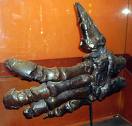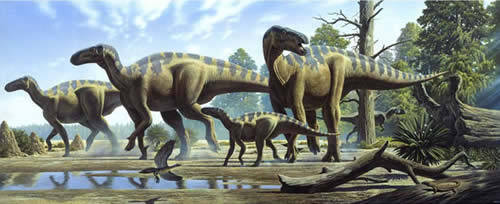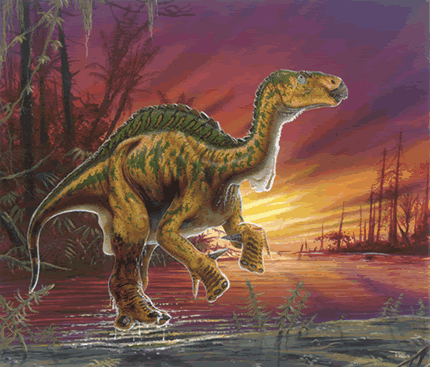Iguanodon bernissartensis - European Dinosaurs
Homepage > European Dinosaurs - Iguanodon bernissartensis
(ig-wahn-oh-don)
"Iguana tooth"
Describer
Also Known As
?Heterosaurus Cornuel, 1850
Hikanodon Keferstein, 1834
"Iguanoides" Conybeare vide Cadbury, 2000 (nomen nudum)
"Iguanosaurus" [Anonymous] 1824 (nomen nudum)
"Proiguanodon" van den Broeck, 1900 (nomen nudum)
?Sphenospondylus Seeley, 1882
Therosaurus Fitzinger, 1840
?Vectisaurus Hulke, 1879
Type of Species bernissartensis
Order Ornithischia
SubOrder Cerapoda
InfraOrder Ornithopoda
Micro-Order --
Family Iguanodontidae
Size 33 feet (10 meters) long
Period Early Cretaceous, 110 million years ago
Fossilsite South Dakota, Utah, USA; Europe
Diet Herbivore
Iguanodon lived during the Early Cretaceous Period, about 110 million years ago. Iguanodon fossils have been discovered in South Dakota, Utah, USA; and in Europe. Iguanodon was the largest member of its family. It could stand three times the height of a man and weight up to 4.5 tons. Iguanodon is one of the most famous dinosaurs and a more primitive relative of the duck-billed hadrosaurs. because it was discovered in 1822, by Mary Mantell, when dinosaurs were still unknown to science. Iguanodon was the second dinosaur discovered and identified by scientists.
 Iguanodon
featured a large thumb spike used for scraping up plants or perhaps it
was used for self defense. These spikes were mistakenly thought to be
horns when first discovered. Iguanodon was a very successful plant eater
with a long skull, beaklike jaws, and rows of grinding cheek teeth that
help to distinguish ornithopods from other herbivorous dinosaurs. An impressive
closely packed battery of teeth, made Iguanodon well suitable for grinding
tough plant material. The upper surface of each tooth was broad and ridged.
Iguanodon
featured a large thumb spike used for scraping up plants or perhaps it
was used for self defense. These spikes were mistakenly thought to be
horns when first discovered. Iguanodon was a very successful plant eater
with a long skull, beaklike jaws, and rows of grinding cheek teeth that
help to distinguish ornithopods from other herbivorous dinosaurs. An impressive
closely packed battery of teeth, made Iguanodon well suitable for grinding
tough plant material. The upper surface of each tooth was broad and ridged.
Study of Iguanodon specimens showed that, far from being heavy, lumbering quadruped. Iguanodon was relatively light in contrast to its great length and could move on its hindlimbs. Studies of its front legs suggest that Iguanodon had strong legs and that the central three fingers ended in hooves. This implied that Iguanodon spent some time on all fours, and probably ran on its hindlimbs when it needed to move quickly.
Iguanodon bernissartensis Paleo Gallery
Click on images to see more art from artist!

